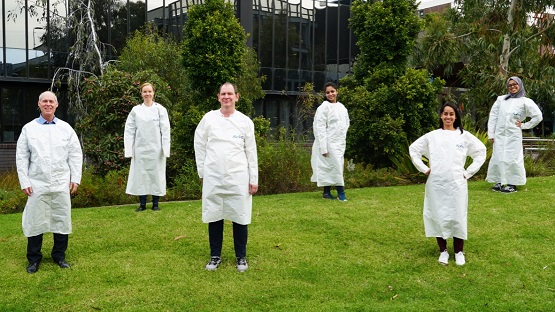- In partnership with an industrial consortium, Monash University researchers have come up with a simple, cost-effective and scalable paper-based medical gown that can be distributed globally in the battle against COVID-19.
- Researchers engineered medical gowns for health care workers and patients by using laminated bleached and newsprint papers with polyethylene coatings.
- This is the first time paper has been used to produce medical gowns.
As mass shortages, poorly manufactured and the misuse of personal protective equipment (PPE) continue to plague many countries in their fight against COVID-19, Monash University researchers have come up with a simple, cost-effective and industrially scalable solution to keep health workers and patients safe.
Researchers at Monash University’s BioPRIA, Department of Chemical Engineering and School of Biological Sciences have created medical gowns for health care workers and first responders using paper laminated with a coating of polyethylene – a lightweight thermoplastic.
Paper has never been used to produce medical gowns with viral protection. However, this innovation could see the mass rollout of high quality PPE to vulnerable communities across the world.
Machine glazed bleached and newsprint papers were laminated with polyethylene coatings of different thicknesses, before being characterised for their potential use as medical gowns for health care workers and COVID-19 patients.
The findings show paper could be the missing element in creating alternative materials for PPE to reduce the spread of COVID-19 and keep people safe.
“The global pandemic, spike in demand, and shortage of traditional PPE materials suitable for viral transmission protection has driven researchers, virologists and biomedical experts to collaborate and explore low cost alternative materials for medical gowns and other PPE,” lead author and Director of BioPRIA at Monash University, Professor Gil Garnier, said.
“In the absence of genuine and appropriate PPE, many workers have adopted makeshift solutions, such as wearing plastic garbage bags as gowns, which fail to provide any protection and contribute to the spread of COVID-19.
“Suitable medical gowns must meet a number of requirements for tensile strength, seam strength, water penetration, hydrostatic pressure and viral protection. While paper is not an obvious material to manufacture gowns, it is easily accessible and produced in most countries.”
Working with their industrial partners from the ARC Industry Transformation Hub PALS (Processing Advanced Lignocellulosics), the research team engineered virus safe medical gowns with both bleached Kraft paper and newsprint paper as the base material, and tested their viral protection, seam strengths and water vapour transmission rates when coated with layers of polyethylene.
Using fluorescent staining, researchers were able to test the penetration of the Phi-X174 bacteriophage – a single-stranded DNA virus that infects E-coli, and the first DNA-based genome to be sequenced – on the paper gowns.
If the virus were able to penetrate the polyethylene coating, create a hole and expose the paper, the fluorescent dye would mark each defect with a ‘stain’.
Researchers identified a combination of 49 GSM bleached Kraft paper with a 16 GSM polyethylene coating showed high tensile and seam strength, low water vapour transmission rate, and the hindering of virus penetration.
Professor Mark Banaszak Holl, Co-author and Head of Monash University’s Department of Chemical Engineering, said paper might not seem like a wise choice because of its perceived weakness, high porosity and high wicking ability.
“However, two events have challenged this conception. The first is the COVID-19 crisis that has drastically limited access to the usual polyolefin non-woven materials, now mostly manufactured in Asia for the world. Contrastingly, paper is manufactured on all the inhabited continents and in most countries,” Professor Banaszak Holl said.
“The second is the advance of paper as an engineered material. Substantial progress in performance has been achieved in the last decade.
“Laminated paper is a non-woven material with significant potential for use in medical gowns. The inherent properties, ubiquitous availability, low cost, agile paper production and lamination processes make this material widely available, suitable to address the health-care criteria, and able to adapt to rapid changes in demand during a pandemic event or other emergency that results in critical PPE shortage situations.”
This project was supported by the ARC Research Hub for Processing Lignocellulosic into High Value Products (PALS) and the Australian Pulp and Paper Technical Association (APPITA). Polyethylene was collected from Qenos Pty Ltd. Machine glazed bleached eucalyptus paper was collected from Opal, Maryvale, Vic, Australia (formerly known as Australian Paper) and newsprint paper was collected from Norske Skog Boyer, Australia.
Professor Gil Garnier (BioPRIA, Department of Chemical Engineering) led the research, with research support from Professor Mark Banaszak Holl, Jinhee Kim and Kevin Putera (BioPRIA and Chemical Engineering); Laila Hossain, Maisha Maliha, Ruth Barajas-Ledesma and Dr Joanne Tanner (Chemical Engineering), and Dinesh Subedi and Dr Jeremy Barr (School of Biological Sciences).
This article is first featured in Monash Media Releases, 3rd February 2021.



